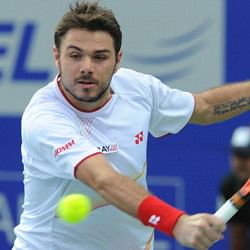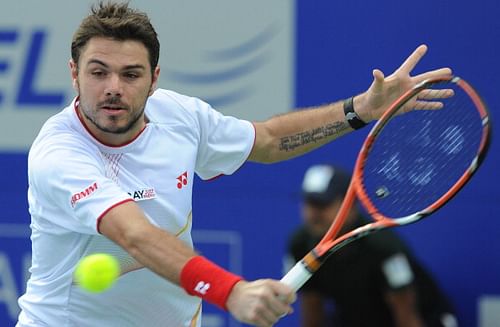
Talking Tactics: Stanislas Wawrinka powers through against Edouard Roger-Vasselin to triumph in Chennai

Stanislas Wawrinka of Switzerland plays a shot against Edouard Roger-Vasselin of France during their tennis final match at the Chennai Open
Switzerland’s Stanislas Wawrinka completed a straight sets win over France’s Edouard Roger-Vasselin on Sunday to win his second Chennai Open crown. The top seed lived up to his billing and finished the opening week of the 2014 ATP Tour on a high.
After winning a tight opening set, Wawrinka managed to assert himself a lot more in the second set, in the process running away with it comfortably in the end. In hindsight, the first set, as is the case many big matches, proved to be crucial in the grand scheme of things in determining the fortunes of this match for both Wawrinka and Roger-Vasselin.
The match as such made for a good contest with both players sticking to well-prepared game plans aimed at disconcerting their opponents on the day. Analysing the game courtside, these were the major plays that stood out.
Roger-Vasselin’s net forays
The No.7 seed made a concerted effort to be aggressive against his higher ranked opponent and part of it involved making repeated forays to the net. On 90% of such instances, Roger-Vasselin decided to play the approach shot to Wawrinka’s forehand, clearly wary of the Swiss’ lethal one-hander.
It worked in most cases, even in situations where it was too obvious that he would go to Wawrinka’s forehand side and it helped in keeping his opponent confused for a while.
While the approach shots went to the Wawrinka forehand almost every single time, whenever he had to play a volley at the net, it almost inevitably went to the backhand side, be it the drop volley, or the topspin drive. He got burnt a few times on those as Wawrinka managed to get around the ball to hit a passing shot, or to use the angle with the backhand and go for a winner with the crosscourt dink.
Roger-Vasselin was the more aggressive the whole match in coming to the net while Wawrinka was content to play from the back of the court.
Focus on the Vasselin backhand, Stan goes backhand to backhand
Wawrinka, in the early part of the game, seemed content on duelling on the backhand, sending it crosscourt to that of his opponent’s. As good as Roger-Vasselin’s forehand is, the backhand is more of a safety shot and is the wing that collapses for the Frenchman. Wawrinka seemed to be making a concerted effort to do just that by playing his favoured backhand to that very wing.
However, Roger-Vasselin kept his backhand rock-steady for much of the opening set resulting in the strategy not paying off so well for the Swiss.
In fact, if anything, Roger-Vasselin’s backhand down the line was working better than that of Wawrinka’s.
Towards the end of the set though, with him searching for an opening, Wawrinka decided to make two changes – mixing up the backhand to go centre and to the forehand, and second, when he did go the backhand, decided to take some pace off and go for more of an angle.
This ended up catching Roger-Vasselin flat-footed a couple of times as he seemed a little confused as to where the ball was going to end up as against the somewhat predictable nature earlier.
Depth of Roger-Vasselin’s shots
After the initial few games where both players did well to hold their serves, Roger-Vasselin upped his game significantly to try and land a break by getting more depth on his shots.
The depth hurt Wawrinka and led to the Swiss making quite a few unforced errors, either sending the ball long or not clearing the net. And with Roger-Vasselin’s backhand working pretty well, Wawrinka found it tough to catch out his opponent on the court.
Soon, he started to make those returns in deep as well which troubled Wawrinka.
But Wawrinka’s serve held firm
The serve was one aspect that was always going to be extremely important. Both players had a high percentage of first serves and Roger-Vasselin employed good variety in his serving. He saved four break points before ultimately conceding the crucial one in the 11th game, and the serve had a large part to play in that scenario.
Wawrinka too wasn’t doing all that badly on his own serve. There wasn’t as much mixing up as seen from Roger-Vasselin, but the Swiss’ serves were harder and tough to retrieve. Though Roger-Vasselin forced quite a few 30-30 situations, Wawrinka had just one break point against him and he managed to save that as well.
His delivery on the second offering was of a high quality and an area emerged where the difference between the top 10 player and top 50 player became apparent.
The cookie finally crumbles – Roger-Vasselin’s second serve comes up short and the backhand breaks down
The stretch of points at the end of the first set that led to Wawrinka breaking in the 11th game and then going on to serve out the set were some very costly backhand errors from Roger-Vasselin. Slowly but surely, Wawrinka managed to break down that wing. He did it by taking the ball on his backhand a little earlier and swinging through the shot to land the ball deep through the middle. Once he had his opponent caught in the middle of the court, he then used his shots expertly to go behind Roger-Vasselin.
As Stan was figuring out a successful strategy, the second serve of the runner-up was another major talking point. Roger-Vasselin wont just 41% of his second serve points in the first set while falling even further to just 25% in the second set. In contrast, Wawrinka had more than 65% success rate on his second serves further underlining how influential his own serve was.
The relatively weak second offering enabled Wawrinka to put some pressure early on in the point by being aggressive with his returns and making every game a struggle for Roger-Vasselin.
Taking full advantage of that, Wawrinka eventually sealed the win and clinched his fifth career title.